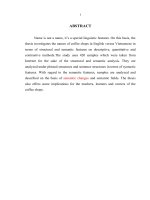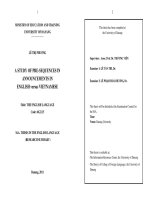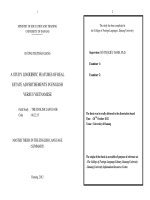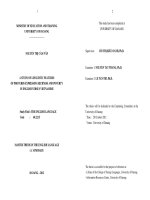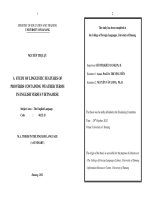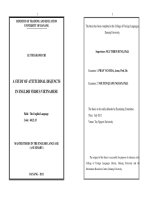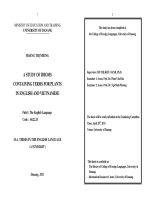Idioms about appearance and personality in english and vietnamese
Bạn đang xem bản rút gọn của tài liệu. Xem và tải ngay bản đầy đủ của tài liệu tại đây (1 MB, 67 trang )
HANOI OPEN UNIVERSITY
FACULTY OF ENGLISH
-----------------------------------
CODE : 22
GRADUATION THESIS
B.A DEGREE IN ENGLISH STUDIES
IDIOMS ABOUT APPEARANCE AND PERSONALITY IN
ENGLISH AND VIETNAMESE
Supervisor
: NGUYỄN THẾ HÓA
Student
: NGUYỄN THÙY LINH
Date of birth
: 04/09/1994
Course
: K19A06 (2012-2016)
HANOI, 2016
HANOI OPEN UNIVERSITY
FACULTY OF ENGLISH
-----------------------------------
CODE : 22
GRADUATION THESIS
B.A DEGREE IN ENGLISH STUDIES
IDIOMS ABOUT APPEARANCE AND PERSONALITY IN
ENGLISH AND VIETNAMESE
Supervisor
: NGUYỄN THẾ HÓA
Student
: NGUYỄN THÙY LINH
Date of birth
: 04/09/1994
Course
: K19A06 (2012-2016)
HANOI, 2016
DECLARATION
I certify that no part of the above report has been copied or reproduced by me
from any other’s work without acknowledgement and that the report is originally
written by me under strict guidance of my supervisor.
Hanoi, 28th . April, 2016
Student
Supervisor
signature
signature
ACKNOWLEDGEMENTS
The graduation paper is written under the supervisor of Mr. The Hoa Nguyen,
the senior lecturer of the Faculty of English, Hanoi Open University.
First of all, my profound gratitude would be expressed to my supervisor, Mr.
The Hoa Nguyen, for his precious advice, suggestion and inspiration.
Secondly, my sincere thanks go to all my teacher in the Faculty of English for
their lectures and instructions which definitely are useful for my research.
I also would like to express my gratefulness to my peers, my friends for their
encouragement and help to complete the graduation paper.
Finally, my heartfelt thanks are to my family for their unconditional support
and love.
Hanoi, 28th April, 2016
Nguyen Thuy Linh
DECLARATION
ACKOWLEDGEMENTS
TABLE OF CONTENTS
LIST OF FIGURES AND TABLES
PART A – INTRODUCTION……………………………………………1
1. Rationale…………………………………………………………1
2. Aims of the study…………………………………………….…..2
3. Scope of the study……………………………………………......2
4. Methods of the study……………………………………………..2
5. Design of the study……………………………………………….3
PART B – DEVELOPMENT……………………………………………..4
CHAPTER 1 – LITERATURE REVIEW…………………………….....4
1.1 Literature review…………………………………………………4
1.2 Definition of idioms…………………………………………..….5
1.2.1 Definition of English idioms……………...…….….…...…..7
1.2.2 Definition of Vietnamese idioms……………………...……8
1.3 The importance of idioms for English language learners...............9
1.4 What is meant by “idiomatic variants”?.......................................14
1.5 What is meant by “synonymous idioms”?....................................15
1.6 Classification of idioms………………………………………....15
1.7 Main features of idioms in English and Vietnamese…………....19
1.7.1 Semantic features…………………………………….….…19
1.7.2 Structural features…………………………………..……...21
1.8 Functions of idioms…………………………………..……..…...23
1.9 Major functions of idioms in human discourse………………….26
CHAPTER 2 – IDIOMS ABOUT HUMAN APPEARANCE AND
CHARACTER IN ENGLISH AND VIETNAMESE…………………...28
2.1 Comparison idioms……………………………………………...28
2.1.1 Introduction…………….………………...………………28
2.1.2 Idioms of comparison…………………………………….29
a. Concepts of idioms of comparison in English and
Vietnamese…...…………………………………………...29
b. Forms/structures of idioms of comparison in English and
Vietnamese…………………………………………...…...30
2.2 Idioms of comparison referring to human interior qualities
(characteristics)……...................................................................33
2.2.1 Idioms of comparison which denote human good interior
qualities…...………………………………………………34
2.2.2 Idioms of comparison which denote human bad interior
qualities…...……………………………………….………38
2.3 Idioms of comparison referring to human character and appearance
(behaviors and conditions………………………………………42
2.4 Similarities and differences in English and Vietnamese idioms of
comparison referring to human appearance and personality…...50
2.5 Summary……………………………………...…………….…....53
CHAPTER 3 – SOLUTIONS FOR BETTER TRANSLATION AND SOME
TEACHING IMPLICATIONS…………………………………….…….54
3.1 Implications for translation……………………………………...54
3.2 Implications for language teaching……………………………...56
PART C – CONCLUSION……………………………………………….58
REFERENCE……………………………………………………………..60
PART A : INTRODUCTION
1. Rationale
The most important purpose of studying one language would be how to
use the language like native speakers. Idiom could be one of the aspect would
make a language learner speak more naturally. Idiom is often used flexibly in
daily life or even in literature. The more idioms a learner knows, the more
native sound-alike conversations he could make.
Idioms make a language sound more creative, and can also get others to
think and figure out what the person who is using the idiom might mean.
Using the literal language (as in saying things directly without any creativity)
sounds very common, and it seems quite boring when they are used in story
books. Idioms in a context makes the context nicely and creatively. Good
writers often use idiomatic expressions, and sometimes they have a different
meaning. It’s mostly a challenging thing, and using idioms in essay might
earn more marks and make a better impression. Therefore, learning idioms is
important.
Every country or nation has got their own idioms that are specific to their
culture, while many idioms have synonyms in several countries which refer to
the equal shared human nature in many cultures. Learning the specific idioms
related to a certain culture helps you learn more about the history, customary
beliefs, social forms, and material traits of it.
Idioms also refect accumulated human experiences and are built on
frequently occurring situations, that demonstrate human behavior, social traits,
1
certain habits or tradition in a country. So are Vietnamese idioms. They
represent life lessons and are a heritage of those accumulated events that
make up the conscious of a nation or humankind in general. They also are
treasure of older generations. Besides using in daily life conversation,
Vietnamese idioms also appear through songs and literature which help to
build and conserve the national identity.
Using idioms competently in both English and Vietnamese could be a
advantage pushing in improving language skills and have a deep
understanding about culture.
2. Aims and objectives of the study
This paper aims to detect wide and full definition of idioms, types of it and
to point out similarities and differences between English and Vietnamese
idiom in term of appearance and personality. Besides, this will show
difficulties in translating English into Vietnamese and provide some solutions
to cope with them.
3. Scope of the study
This study will focus on English and Vietnamese idioms of appearance
and personality.
4. Methods of the study
This paper uses constrating analysis to make English and Vietnamese
idioms clearer. The sources for the analysis are from materials and references
written by linguists in English and in Vietnamese as well as some bilingual
2
reference books available in Vietnam. This will help to make clear both the
similarities and the differences between the idiomatic variants and
synonymous idioms in English and those in Vietnamese.
Techniques for analyzing materials:
-
English and Vietnamese idiomatic variants and synonymous idioms
are investigated in many of their aspects such as appearances, forms,
component orders, characteristics, meaning colors, figurative styles
etc. Basing on this, the author has tried to find out the similarities and
differences between English idiomatic variants and synonymous
idioms and Vietnamese ones.
-
Description and comparison are carried in the order of different
groups of subjects by using some techniques such as contrastive
analysis, componential analysis, transformable analysis and statistics.
Moreover, frequent talks with the supervisor, lecturers and experts on the
field have proved to be a very useful method for the completion of the study.
Also, the study is carried out on the basis of the author’s personal experience.
5. Design of the study
This paper has three main parts. Part A is the introduction about the
rationale, aim and objectives of the study, scope of the study, methods and the
design of the study.
Part B mentions the development for this paper and consists of three
chapters. Chapter 1 talks about literature reviews, chapter 2 states idioms
about human appearance and character in English and Vietnamese , and
chapter 3 shows the contributions and solutions.
3
Part C is conclusion and recommendation. The end of the study is the
references.
PART B : DEVELOPMENT
CHAPTER 1: LITERATURE REVIEW
1.1 Literature review
In “Essential Idioms in English” (2003), idioms are listed and have their
meaning explained with illustrating examples. Palmer clearly states some
restrictions in syntactic as well as semantic features in idioms. In “An
Introduction to Functional Grammar”(1985) by Halliday, there has been the
explanation of structural grammar, the relationship between grammar and
semantic, and especially in the light of Halliday’s view, idioms are regarded
as a class of group. Seidl and McMordie write “English Idioms and How to
Use Them” (1954). Besides, in “Oxford Idioms Dictionary for Learners of
English” (2007) , there is a wide range of idioms, from expressions used in
business and newspapers to very up-to-date informal English and slang
expressions.
Concerning Vietnamese idioms, there have been a lot of studies by various
linguists such as “Từ điển thành ngữ tục ngữ Việt – Anh tường giải” by Bùi
Phụng (2000), “Từ điển giải thích thành ngữ tiếng Việt” by Nguyễn Như Ý
(1995) , “Từ điển thành ngữ tục ngữ ca dao Việt Nam” by Việt Chương
(1995) , “Từ điển thành ngữ Việt- Anh” by Trần Phong Giao (2010). In
addition, there have been so far some master theses in English on idioms
carried out by many Vietnamese researchers. Nguyen Van Long has done
4
researches into “Semantic Features of English and Vietnamese Idiomatic
Verb Phrases” and “Linguistic Features of English and Vietnamese Idioms”
(2010). Nguyen Thi Dieu Hao focuses on the study of idioms containing
color words in English and Vietnamese.Vo Thanh Quyen makes a contrastive
analysis of idioms denoting Human Being in English and Vietnamese.
Nguyen Thi Phuong Thu studies “The Syntactic and Semantic Features of
English and Vietnamese Idioms Containing Verbs of Motion” (2008).
Moreover, Nguyen Thi Thu Mai investigates “The Syntactic and Semantic
Features of Idioms Denoting Causes and Results (English Versus
Vietnamese)”. It could be seen that the linguistic features of idioms
expressing distance in English versus Vietnamese have not been so far
investigated.
1.2. Definition of idioms:
Each word certainly has its own meaning. However, words do not just
exist separately and individually, they, in fact, also come in groups or
expressions. Idioms can be said to be one of the most common expressions
that one must acquire if he/she wants to master a language. What is an idiom?
Hornby stated in his Oxford Advanced Learner’s Dictionary (1995) that an
idiom is “a phrase or sentence whose meaning is not clear from the meaning
of its individual words and which must be learnt as a whole unit”. In Oxford
Advanced Learner’s Dictionary (2006), Hornby changed the definition a little
bit, noting that an idiom is “a group of words whose meaning is different
from the meanings of the individual words”. (p. 740). To put it in a simple
way, an idiom is a phrase in which the words together have a meaning that is
5
somehow different from the dictionary definitions of the individual words,
which can make idioms arduous to understand. It should be kept in mind that
an idiom is differentiated from a collocation since a collocation is, according
to Cruse (1986), “a sequence of lexical items which habitually co-occur and
each lexical constituent is also a semantic constituent.” (p. 40).
The number of idioms in English is considerable. Some interesting
examples are: “It was for the birds” (means: It’s is really meaningless and
uninteresting), or “to bury the hatchet” (to make peace), “to call it a day” (to
stop doing something), “to paint the town red” (to carouse and have a good
time), ...
In Vietnamese, we also possess a lot of idioms, such as: “Nghèo rớt mùng
tơi” (Very poor, penniless); “Chọc gậy bánh xe” (to prevent someone from
doing something they have planned); “cao chạy xa bay” (to flee, to run
away)…
Idioms can make perfect examples of figurative language, in that the
overall meaning of an idiom can not be predicted from the composition of the
literal meanings of the constituent parts. For example, we can not predict that
these idioms up in arm or down in the mouth mean very angry. Idioms in both
English and Vietnamese are structurally and lexically closely-combined
phrases whose meanings are completely different from their component parts.
In general, idioms are the products of national culture and social life. They
are conventionally lexicalized linguistic units and ready-made utterances.
Structually, idioms are fixed expressions; they don’t permit the usual
variability displaying in other contexts. From the semantic point of view,
6
idioms must be interpreted in connection with the historical and cultural
characteristics.
1.2.1 Definition of English idioms
- According to Jenifer Seidl and W.Mc Mordie in “English Idiom and How
to Use” “an idiom is a number of words which, taken together, mean
something different from the individual words of the idiom when they
stand alone.” (1979: 20)The Longman Dictionary of Language Teaching
and Applied Linguistics regards an idiom as “an expression which
function as a single unit and whose meaning can not be worked out from
its separate parts” (1992: 198). In the Oxford Advanced Learner’s
Dictionary of Current English (Oxford University Press - 1995) defines
idiom as “a phrase or sentence whose meaning is not clear from the
meaning of its individual words and which must be learnt as a whole unit.”
(1995: 67).
- Ammer defines an idiom as a set phrase of two or more words that means
something different from the literal meaning of the individual words. As
for Cruse [p.37], an idiom is an expression whose meaning cannot be
accounted for as a compositional function of the meanings its parts have
when they are not parts of idioms. With the aim of structural and semantic
analysis in both English and Vietnamese about people, we decided to
choose Cruse's definition [p.37] as the foundational one for this study.
7
On reflection, it could be seen that there is no conflict between therefore
mentioned definitions of idiom. Regardless of obvious differences in
expressing, they intersect at one point: an idiom is a fixed expression whose
meaning can not be worked out by combining the literal meaning of its
individual words.
1.2.2 Definition of Vietnamese idioms
In Vietnamese, Hoàng Văn Hành [p.31] considered an idiom as "một loại
tổ hợp từ cố định, bền vững về hình thái - cấu trúc, hoàn chỉnh, bóng bẩy về ý
nghĩa, được sử dụng rộng rãi trong giao tiếp hằng ngày" (a fixed group of
words which is firm in terms of morphor-structure, complete and figurative in
terms of meaning, and is widely used in daily speaking).
According to “Thuật ngữ ngôn ngữ học” , idiom is “cụm từ hay ngữ cố
định có tình nguyên khối về ngữ nghĩa, tạo thành một chỉnh thể định danh có
ý nghĩa chung khác tổng số ý nghĩa của các thành tố cấu thành nó, tức là
không có nghĩa đen và hoạt động như một từ riêng biệt trong câu.” (Is a
phrase or a fixed term with the semantic monolithic, form an identifiable
whole other common sense of the meaning of its constituent elements, has no
literal meaning and acts as a separate from the sentence.)
In Wikipedia, it is written “Thành ngữ hoặc là những cụm từ mang ngữ
nghĩa cố định (phần lớn không tạo thành câu hoàn chỉnh về mặt ngữ pháp)
(không thể thay thế và sửa đổi về mặt ngôn từ) và độc lập riêng rẽ với từ ngữ
hay hình ảnh mà thành ngữ sử dụng, thành ngữ thường được sử dụng trong
việc tạo thành những câu nói hoàn chỉnh. Thành ngữ là tập hợp từ cố định đã
quen dùng mà nghĩa của nó thường không thể giải thích được một cách đơn
8
giản bằng nghĩa của các từ tạo nên nó. Cần phân biệt thành ngữ và tục ngữ.”
(Idioms are fixed semantic phrases (mostly not form complete sentences
grammatically) (irreplaceable and amended in rhetoric) separately and
independently with words or images which uses expressions, idioms are often
used in the form of a complete sentence. Idioms are fixed set of words that
are familiar with its meaning often can not be explained simply by means of
words that make it up. Need to distinguish idioms and proverbs.)
VD:
Tốt gỗ hơn tốt nước sơn (Good wood better than paint)
Hổ phụ sinh hổ tử (Like father like son)
Con ông cháu cha (Accident of birth)
1.3 The importance of idioms for English language learners
“Since idiomatic expressions are so frequently
encountered
in
both
spoken
and
written
discourse, they require special attention in
language programs and should not be relegated
to a position of secondary importance in the
curriculum”.
Cooper, 1998
The English language being very flexible constantly enriches its
vocabulary with words invented by language speakers, making it more
colourful with new idiomatic expressions, and, at times, refills its stocks with
the borrowings and neologisms. English just amazes by its extraordinary
linguistic diversity.
9
The focus of this paper is to share consideration on the importance of
idioms for non-native speakers as part of their mastery of the English
language.
Understanding the lexicon of English demands more than knowing the
denotative meaning of words. It requires its speakers to have connotative
word comprehension and more - an understanding of figurative language.
Idioms fall into the latter category. Learning idioms is certainly not a piece of
cake (very easy), but once you know them, they can be a lot of fun, and
anyway, because English people use idioms non-stop you will be all at sea
(totally confused) in most conversations until you learn the ropes (understand
how things work).
Idioms share cultural and historical information and broaden people’s
understanding and manipulation of a language. Among the various definitions
of idioms are: (1) the language peculiar to a people, country, class,
community or, more rarely, an individual; (2) a construction or expression
having a meaning different from the literal one or not according to the usual
patterns of the language in New Webster’s Dictionary, 1993. It is the second
definition that best suits the focus of this paper. Professor Kounin defined
idiom “as a stable combination of words with a fully over partially figurative
meaning” (Kounin, 1970). This definition emphasizes two inherent and very
important features of idiomatic expressions. Idioms have lexical and
grammatical stability. It implies that they are fixed in their form, hence any
substitution and rearrangement in their structure can lead to a complete loss
of their primary meaning.
10
According to Cooper Th. in Teaching idioms. Foreign language annals
(p.31, 1998) : idioms are always something special about any language; they
build up some distinctive features which differ one language from another.
What is more, idioms reflect certain cultural traditions and depict the national
character.
Idioms are not a separate part of the language which one can choose either
to use or to omit, but they form an essential part of the general vocabulary of
English. A description of how the vocabulary of the language is growing and
changing will help to place idioms in perspective.
Idioms appear in every language, and English has thousands of them.
They are often confusing because the meaning of the whole group of words
taken together has little, often nothing, to do with the meanings of the words
taken one by one.
“In order to understand a language, we must know what the idioms in that
language mean. If we try to figure out the meaning of an idiom literally, word
by word, we will get befuddled. We have to know its hidden meaning.
Because of idioms, learning a language can be complicated.” Cooper Th.
Processing of Idioms by L2 Learners of English. TESOL Quarterly, 33(2),
1999.
Since vocabulary and culture are intertwined, speakers can gain more
vocabulary through idioms and conversely, can learn more about idioms from
being exposed to the target culture. The more comprehensible input there is,
the more learners’ listening, speaking, writing and reading skills will improve.
“There are certain things that happen in every culture and there are idioms
to deal with them.” (New Webster,1993).
11
In Norwegian and Czech, “walking around hot porridge” refers to beating
around the bush, which is also an idiom meaning not getting to the point.
If you are in Italy or Turkey and you say you are “as hungry as a wolf”
then you are starving.
In Finnish, “with long teeth” means you are doing something that you
really don’t want to do.
In French, “to have long teeth” means you are ambitious.
If it is raining in large amounts, most cultures have an interesting way of
saying that:
In English, it would be “raining cats and dogs”,
In Africa, they might say “it's raining old women with clubs.”
Many languages refer to heavy rain as coming in buckets or as rain
coming out of a bucket.
In Norway they say “it's raining female trolls”;
The Irish say “it's throwing cobblers knives.”
An idiom’s semantics can be influenced by national colouring. There are
many cases when phrases are based on an old English prejudice, and a similar
prejudice known in other countries of the world may lead the reader to some
misunderstanding. For instance, “a black cat crossed her way” would mean
different things to people of different nationalities. To the English people, a
black cat would mean good luck to the extent that some students are even said
to be always looking for a black cat crossing their path on the way to the
college exams. To Americans, it is mostly a black cat that would mean “bad
luck”. (New Webster,1993).
12
All these examples cited above, prove the divisibility and variability of
phraseological units in a particular discourse situation – convincing
manifestations of their unstability.
Idioms are figurative units, they describe the situation in a metaphoric way.
They are often termed as “dead” or “fixed (stable)” metaphors, because many
instances of realia they used to denote have already ceased to exist, as a result,
the metaphoric character is lost to the modern speaker. Some linguists call
them “sleeping” metaphors rather than “dead”: there are speakers who are
very good at “waking them up”. Educated people, students of language often
play upon these idioms amd make them serve their purposes. Thus, the
metaphor underlying an idiom is “brought to life” and gains its new colours.
In Russian linguistics the semantic configuration of an idiom is termed
“deformation” (Izotova, 1988).
Idiomatic expressions pervade English with peculiar flavour and give it
astounding variety, bright character and colour. They help language learners
understand English culture penetrate into customs and lifestyle of the English
history. However, learning idioms presents a host of difficulties to English
learners, primarily because they don’t know the culture and history behind
English idioms. That is why they often use idioms incongruous with the
situation. Indeed, English learners utilize idiomatic expressions very carefully,
being afraid of using them incorrectly and being misunderstood. According to
Cooper (1999), idiom study presents a special language problem for all
language learners because the figurative meaning is unpredictable.
To conclude we may state that the sheer number of idioms and their high
frequency in discourse make them an important aspect of vocabulary
13
acquisition and language learning in general. One of the approaches to
defining this linguistic phenomenon stresses that an idiom is a manner of
speaking that is natural to native speakers of the language. It proves that only
people who are very good at speaking English can adequately and to the point
use idiomatic expressions in their speech. English is a language with a vast
idiomatic basis, which makes its learning very exciting and intriguing. So
grasping the use of idioms is an essensial part of learning English.
1.4 What is meant by “idiomatic variants”?
In “Bases of General Linguistics”, Ju.X. Xtepanov (1956) partly dealt with
variants. He said that phonetic variation of words had its own limitation
performed by synonyms. It means that the forms of the words change but
their meanings are the same. That a word is pronounced in two ways makes
two phonetic variants of a word.
“Variant" is something which differs in form from another thing, though
really the same; as, a variant from a type in natural history; a variant of a
story or a word.
Basing on these, we can say that idiomatic variants are idioms having the
same meanings and grammatical structures or having different components
belonging to the same field of meaning.
14
1.5 What is meant by “synonymous idioms”?
“Synonym" is one of two or more words (commonly words of the same
language) which are equivalents of each other, one of two or more words
which have very nearly the same signification, and therefore may often be
used interchangeably.
It can be said that Russian linguists have recorded great achievements of
synonymy, especially synonymous idioms. T.A. Bertagaep and V.I Zimin ,
Essensial Russian- English Dictionary (1967) referred to synonymous idioms
(synonymous idiomatic groups of words) in modern Russian. Basing on the
structures of synonymous idioms, they gave the concept of idiomatic variants
and the opposite of idiomatic variants and synonymous idioms. They
supposed that synonymous idioms were idiomatic groups of words which had
the same meanings but different expressive colours belonging to different
functional styles of the language.
In Vietnam, Do Huu Chau in “Từ vựng ngữ nghĩa tiếng Việt” (1981) has
partly referred to the synonymous idioms. He said “The idioms which are
about the same as words are mainly synonymous, colorific and descriptive”.
It means that synonymous idioms are idioms having the same meanings but
different structures or having the same structures but different components
belonging to different fields of meaning.
1.6 Classification of idioms
Contrasting views of the meanings of idioms lead to the classification of
idioms as well. Whether the meaning of an idiom can be worked out from the
meanings of its component parts?
15
From the cognitive standpoint, the meanings of an idiom’s constituent
parts help people to understand the meaning of an idiom. Nevertherless, the
relation between the form and the meaning of an idiom may not always be
completely direct. R.W.Gibbs and N.P.Nayak in their book Psycholinguistic
Studies On The Syntatic Behavior Of Idioms. Cognitive Psychology, 1989
classify idioms into “decomposable / compositional / analyzable idioms” and
“non-decomposable / non-compositional / unanalyzable idioms”.
Decomposable idioms are those whose constituent parts contribute to the
overall idiomatic interpretation, and they tent to be syntactically variable.
Non-decomposable idioms are those whose constituent parts do not
contribute to the overall idiomatic interpretation, and their opaque semantics
make them not subject to syntactic flexibility.
Decomposable idioms are also sub-divided into normally decomposable
idioms and abnormally decomposable idioms. Idioms that have an one-to-one
relation in which each word contributes independently to the figurative
interpretation are categorized as normally decomposable idioms, e.g. the
idiom “spill the beans” and the semantic relation between “to spill” and “to
tell” , “the bean” and “the secret”
“to spill the beans” means “ to tell
somebody something that should be kept secret or private” (Oxford Idioms
Dictionary, O.U.P,2001. p. 368). Abnormally decomposable idioms, on the
other hand, have an all-to-one relation with the literal meaning of the whole
phrase being semantically related to the figurative interpretation, e.g. “push
the panic button”.
16
There are many ways to classify idioms into different categories. The
classification method can be based on the structures (of both content and
forms), the meanings, the origins, the functions, etc. In Vietnamese, idioms
can also be divided into different groups like those of the English idioms. Yet
the main way to categorize Vietnamese idioms in anchored in the structures
of idioms. According to that method, Vietnamese idioms can be grouped into
two main categories: metaphoric idioms, and idioms of comparison.
Metaphoric idioms are idioms which contain metaphors. Metaphoric
idioms are principally based on the description of certain events or
phenomena. The form, the constituent parts (or in general, the “appearance”)
of a metaphoric idiom do not always reflect its entire meaning hidden behind
the words. Such “appearance”, to some extent, only functions as the primary
clue to recognize the “surface” meaning of the idiom. Then with the help of
that “surface” meaning , the entire concealed meaning of the idiom can be
understood.
Mai Ngọc Chừ, Vũ Đức Nghiệu and Hoàng Trọng Phiến in Cơ sở ngôn
ngữ học và tiếng Việt, Education Publishing House, 1997, p. 153-165 present
an example of metaphoric idioms: “Ngã vào võng đào”.
- “Ngã” means “ fall” or “someone falls”, which implies unluckiness.
- “Võng đào” means a good, sumptuous hammock.
“ Ngã vào võng đào” means “fallling into a good, luxurious hammock”,
that is the “surface” meaning of this idiom.
From the “surface" or the apparent meaning of this idiom, people will
refer to its further figurative meaning, that is “there is something hopeful
about even in the most difficult or unlucky situations”. In English, there are
17
also some idioms which bare the equivalent meaning such as Every cloud has
a silver lining, Misfortune has its senses, No great loss without small gain, If
the sky falls , we shall catch larks. (Moon, Fixed Expressions and Idioms in
English: A corpus based, 1998).
Moon (1998) also pointed out that metaphoric idioms can be subdivided
into smaller categories based on their meanings, and structures : metaphoric
idioms depicting certain events, incidents, or phenomena; metaphoric idioms
describing two similar domains; and metaphoric diioms describing two
contrasting domains, objects.
In Cơ sở ngôn ngữ học và tiếng Việt, (1997) , Mai Ngọc Chừ, Vũ Đức
Nghiệu and Hoàng Trọng Phiến demonstrates that a metaphoric idiom that
depicts a certain event, incident, or phenomena, there is only one domain
portrayed. Thus, only one image, one message is implied, e.g. Ngã vào võng
đào, Nuôi ong tay áo, Nước đổ đầu vịt, Chó có váy lĩnh, Hàng thịt nguýt hàng
cá, Vải thưa che mắt thánh, Múa rìu qua mắt thợ, etc.
There are two domains which are reflected in the second type of
metaphoric idioms. Those domains are comparatively compatible with each
other, e.g. Ba đầu sáu tay, Nói có sách mách có chứng, Ăn trên ngồi trốc, Mẹ
tròn con vuông, Hòn đất ném đi hòn chì ném lại, etc. (Cơ sở ngôn ngữ học và
tiếng Việt, (1997) , Mai Ngọc Chừ, Vũ Đức Nghiệu and Hoàng Trọng Phiến).
The third type also describes two phenomena, or two objects, but unlike
those of the second type of metaphoric idioms, the two domains described in
the third type are contrasting with each other, e.g. Một vốn bốn lời, Méo
miệng đòi ăn xôi vò, Miệng thơn thớt dạ ớt ngâm, Bán bò tậu ễnh ương, Xấu
18
máu đòi ăn của độc, etc. (Cơ sở ngôn ngữ học và tiếng Việt, (1997) , Mai
Ngọc Chừ, Vũ Đức Nghiệu and Hoàng Trọng Phiến).
Apart from the categorization method which depends merely on the structures
of idioms, there is another way to classify idioms into various groups. That is
based on the number of words within an idiom. A remarkable feature
regarding to the number of words of Vietnamese idioms is that the idioms
which have even numbers of words (4 words, 6 words, 8 words) account for
approximately 85% of the total amount of Vietnamese idioms. The reason for
that is Vietnamese people are often in favor of using rhythmic intonation and
harmonious tune such as Áo gấm đi đêm, Ăn không nên đọi nói không nên lời,
Bới lông tìm vết, Môn đăng hộ đối, Ngưu tầm ngưu mã tầm mã, etc. (Cơ sở
ngôn ngữ học và tiếng Việt, (1997) , Mai Ngọc Chừ, Vũ Đức Nghiệu and
Hoàng Trọng Phiến).
1.7 Main features of idioms in English and Vietnamese
Idioms have some remarkably special features. In this paper, let’s examine
the two most important ones: semantic and structural features.
1.7.1 Semantic features
Vinogradow (1977) once cleverly likened the meaning of an idiom to “the
special chemical mixture” of the meaning of all the components, which is,
notably and completely new in quality. Just take an example to elucidate his
point: “to give someone the slip”, it would be inappropriate to translate every
word and understand the meaning literally (one has a slip and then he/she
19
